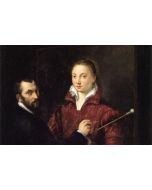A history of modern art in 50 works
This course has now started
- Course Code: VB309
- Dates: 15/04/24 - 01/07/24
- Time: 11:00 - 13:30
- Taught: Mon, Daytime
- Duration: 10 sessions (over 12 weeks)
- Location: Off Site
- Tutor: Sarah Jaffray
Course Code: VB309
Duration: 10 sessions (over 12 weeks)
Please note: We offer a wide variety of financial support to make courses affordable. Just visit our online Help Centre for more information on a range of topics including fees, online learning and FAQs.
What is the course about?
This course provides an introduction to modern art by looking at objects and artworks in London galleries. The period of modernism roughly aligns with the dates 1860-1970. This class begins with impressionism and works its way through various movements like cubism, surrealism, abstract expressionism and pop art. At its end, it strecthes into feminist art and into the contemporary to see how issues of modernism can be felt in the present.
We will explore how modern artists get us to redefine the concept of art and its purpose as site of critical thinking, sensation and perception. We do this through singular objects and artworks in museum spaces so we can get a sense of size, texture and physical impact. We also consider historical context; we discuss how these artworks were products of their time and how we perceive them now.
This course can be studied alone or as a sequel to The History of Art in a 100 Paintings or A History of Art in 100 objects.
We visit several museums in this course including: The Courtauld, Tate Modern, Tate Britain, the V&A and the National Gallery.
What will we cover?
• The history of Modern Art from 1860s to 1960s, moving us into themes of contemporary art
• Styles such as Impressionism, Cubism, Dadaism, Surrealism, Abstract Expressionism, Minimalism, Pop Art and so on in paintings, sculptures, installations and so on through fifty key works
• The relationship between art and theory (colour theory, manifestos).
What will I achieve?
By the end of this course you should be able to...
• Have a good understanding of the chronology of Modern Art from 1900 to the 1970s
• Recognise 50 key works in the history of Modern Art and be able to analyse them
• Have a good grasp of debates around art theory and practice.
What level is the course and do I need any particular skills?
This course is suitable for all levels.
You should be able to follow simple written and verbal instructions, demonstrations, handouts and health and safety information.
How will I be taught, and will there be any work outside the class?
The course will be taught with a mixture of guided gallery visits, group discussion and short group activities.
Handouts will be provided by your tutor, made available digitally on Google Classroom to support your learning on the course. You will be emailed an invitation to the Google Classroom within one week of the course start date. There will be occasional, short, homework to develop ideas discussed in the course.
This course takes place offsite in galleries around London. Offsite courses take place during public access hours. Tutors are not able to control sound levels or behaviours of visitors outside of the course group. Unless you are a wheelchair user, and have confirmed access details with us (as levels of access can vary between buildings), you will need to be able to walk between sites and stand for some time while looking at them (you may bring your own portable stool if you have one, but we cannot guarantee access to seating offsite.) If you feel you may be impacted by these environmental variations, please inform the department on humanities@citylit.ac.uk before the course begins, to discuss reasonable accommodations we can make to assist your learning in offsite.
Are there any other costs? Is there anything I need to bring?
You might wish to purchase a notebook for taking notes. You might wish to buy some of the books on any reading list provided.
Most of the museum collections we visit are free. However, the Courtauld charges an entrance fee; this fee is not included in the cost of this course. You will be sent an email reminder to purchase your Courtauld entrance a week before our visit.
When I've finished, what course can I do next?
You might also be interested in:
Visionary Experiments: American art in the 1940s and 50s
Contemporary art in London.
Sarah Jaffray holds a BA and MA in Art History with an emphasis in 19th/20th century France and a minor in the Italian Renaissance. She holds a second MA in Cultural Theory from Goldsmiths, University of London. Sarah was a lecturer for several colleges and universities in the Los Angeles area before relocating to London in 2012. She has worked in curatorial roles at the British Museum and Wellcome Collection. In addition to her current teaching at City Lit, Sarah is a lecturer at the University of Arts London and the Tutor Coordinator for City Lit's Art History programme. Her art historical practice focuses on experimental narratives, artistic process, art pedagogy, politics and philosophy. Sarah's current research is focused on translation and empathy.
Please note: We reserve the right to change our tutors from those advertised. This happens rarely, but if it does, we are unable to refund fees due to this. Our tutors may have different teaching styles; however we guarantee a consistent quality of teaching in all our courses.
